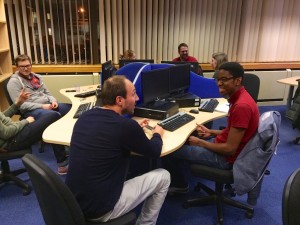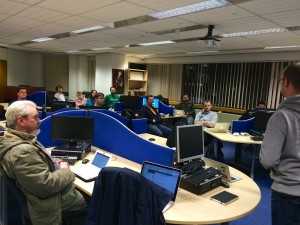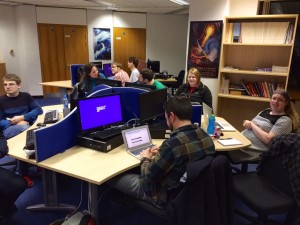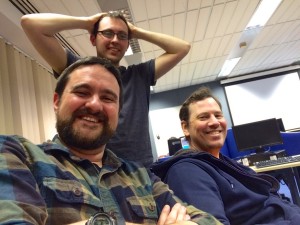Date
Thursday, 28 May 2015 7:00 PM
Venue
K102 – the Octagon building
Supported By:

Back in January, Paul ran a Git on the Command line session where he demonstrated the transparency and learning benefits of using Git in bash. He also hopefully whetted the groups appetite in terms of branchless workflows.
This month, Paul’s going to build on the previous session by digging deeper into branchless development, feature switches, and how to commit and push bite size changes with a practical workshop.
He’s also going to demonstrate using Git bisect to perform binary searching on a code base to demonstrate how to find bugs.
As per the previous session, please bring laptops with Git along, and we assume basic knowledge of the Git CLI.
Date
Thursday, 30 Apr 2015 7:00 PM
Venue
K102 – the Octagon building
Supported By:

An evening looking at retrospectives and why they are vital no matter what Agile process you are using. A short talk by Melinda Marsh, followed by the group sharing experiences of retrospectives.
We will then complete a retrospective of Agile Staffs over the last 6 months. Feel free to come prepared – get your thoughts together so we can create one word cards that for example cover:
– things were good at
– what we can improve
– future things we’d like to try
See you there.
Mel
Date
Thursday, 26 Mar 2015 7:00 PM
Venue
K102 – the Octagon building
Supported By:

vi, and its more recent clone vim, is a tool that has a 30 year legacy and is still gaining new users. In our January Git session; upon committing code at the terminal, vi launched and confounded many of us. It was decided, by the group, to arrange a session on vim. It transpired that Agile Staffordshire already has a number of vim users of varying competency.
Introduction
To begin, I will introduce vim and some of the basic features and ‘modes’ for simple editing. This is designed as a ‘noob-to-noob’ session. I have only been using vim for about 6 months and will be figuratively ‘a page ahead’ of the learner. I will explain some of the differences between standard GUI editors and some of advantages of the vim ‘way of things’.
Further vim
Jason Underhill will continue the session with some additional features; these include:
• Spell check
• Code formatting
• Regular expressions
• searchBuffers, windows and tabs
Plug-ins will also be introduced, demonstrating vim’s extensible architecture, some of which; Ctrl-P, Surround, SuperTab, Endwise and Markdown.
Alternative IDE
Consider notch turned up! Paul Williams will demonstrate why more developers are moving from full-blown IDEs to ‘legacy’ editors, such as vim. He will demonstrate a full terminal workflow using vim and tmux, automatic unit test execution and using a Clojure REPL. Imagine Repl + Test Driven Development without an IDE!
Tooling Up
This will be a practical session, so bring your laptops. Most operating systems have vim available; either installed or via a package manager. The notable exception is Microsoft(R) Windows(R). Visit vim download page. Wi-Fi Internet access has been provided by Staffordshire University in prior events and I expect they will be kind and do it again.
There’s always a great atmosphere and discussion at Agile Staffordshire whenever we have a guest speaker. February did not disappoint. Craig Judson (Operations Manager at Codeweavers) presented Kanban in general and then elaborated on how Kanban is utilised specifically for continuous delivery of software.
Subsequently, a vibrant and energised discussion took place on working practices and project/product management. It was great to have such a varied mix of disciplines and roles present to contribute; consultants, developers, academics and managers. It was particularly interesting to note how various people were adapting well-known techniques to their work place and teams.
Thank you, Craig!

Craig Judson gave a presentation on Kanban and how it is used to deliver software at Codeweavers.
Also in February, Rosie Anderson and Rebecca Mycock stopped by to introduce Outsource. While Agile Staffordshire is primarily a group to share experience, expertise and good practice it is useful to network and learn about jobs, careers and opportunities in the Industry. I am sure that we will welcome them again at some point in the near future. Students may wish to pay attention to our blog for news concerning graduate recruitment (as well as all of the great professional experiences they can learn about). Thank you, Rosie and Rebecca!
Date
Thursday, 26 Feb 2015 7:00 PM
Venue
K102 – the Octagon building
Supported By:

Edit:
To start off the session, Rosie will introduce herself and the challenges she has recruiting developers into agile positions. We hope this might spark an interesting conversation, provide feedback and offer networking opportunities. Whilst there’s no such thing as a free lunch, there may well be free beer* at the pub afterwards. *other beverages available
In last month’s meet up a company adopting agile process asked if we could do a session on Kanban boards to understand how they help with the adoption of agile processes.
This month, we will be doing just that and treating you to an introduction into Kanban boards by Criag Judson @ Codeweavers. Codeweavers transformed from a chaotic software development process to agile, and Craig will be explaining how Kanban helped Codeweavers and how it evolved over time to meet the needs of the business.
This is a guest speaker session, so no need to bring your laptops.
p.s. Craig has presented this work previously, so see the comments section as I’ll be posting the published paper on “Chaos to Kanban”.

Paul Williams gave a great introduction to the group on version control basics with Git
There was a great vibe this January; our first meeting of 2015. Paul Williams opened the year with a great session introducing Git. The session served as a useful introduction to those new to Git as a version control mechanism and incorporated rebasing techniques for those with intermediate skills. We experienced a wide spread of issues related to version control; what else would you expect with up to 20 people trying to do the initial commit? We also had a sneak peak how others are using Git in professional ventures. It was a great fun! Agile Staffordshire enjoyed an enthusiastic turnout; it was lovely to see everyone. Thank you, Paul.
The session provoked some good discussion and even set the scene for our first quarter topics. In March 2015, Agile Staffordshire will hold a session on Vi (the editor that appeared mercilessly upon commits) and more advanced Git techniques in April 2015. February’s session will focus on project management, with a specific discussion on Kanban in relation to software development. Keep watching our blog for upcoming events or join our meet-up group.

Ad-hoc team trying to commit to repositories in ad-hoc ways! What could go wrong? Not much really!

It’s amazing how a bit of Git can make people smile.
I would like to add special thanks to Staffordshire University for hosting our event and providing wireless Internet connectivity throughout the session. Super stuff! Another special mention to Mel for taking photographs!
Date
Thursday, 29 Jan 2015 7:00 PM
Venue
K102 – the Octagon building
Supported By:

Source control is an essential tool in supporting the kind of incremental and confident development and refactoring typical in agile projects. Of all the source control systems, Git is arguably the most popular and feature-full. Github is now the most important service used by the open source community. Git is a distributed system allowing its users to maintain their own local copies of a repository including history. This allows them to work disconnected from their networks and the Internet, and syncronise changes when back online.
However, it’s power does mean a steep learning curve. Most IDEs provide integrated Git support which whilst boosting productivity can restrict learning of the low level concepts and tools that can elevate users from intermediate to advanced.
This session will provide an introduction the the Git command line interface, showing how to do the basic clone, commit, push and pull commands. Building on these concepts it will then move to branching and rebasing finishing with a discussion on the benefits of each approach, and continuous integration without branches.
It’s a technical session, so please bring a computer with the Git command line installed. There are University computers available, and hopefully Cathy might be able to confirm whether they have the Git command line installed.
Comments Off on Christmas Kata and Merriment
Date
Thursday, 11 Dec 2014 7:00 PM
Venue
K102 – the Octagon building
Supported By:

Agile Staffordshire has a delightful evening of kata and merriment planned (loosely).
As a special treat, there is a choice of kata:
• Secret Santa
• Roman Numeral
Secret Santa
Secret Santa is a modern tradition where one anonymously gives a gift to a randomly assigned recipient. Create code that randomly assigns each Agile Staffordshire participant as a ‘santa’ to another participant as the recipient. Each participant must give and receive one gift.
This is a neat kata, with an added bonus for writing good tests to ensure recipient constraints are met.
Some actual presents will be provided, feel free to bring your own goodies if you wish.
Roman Numeral
The Roman Empire was once mighty and large. I suspect one of the reasons it diminished was due to the clunky number system it employed. We still use Roman numerals occasionally on clocks and BBC credits. Write a small program to decode a string of Roman numerals to its decimal value.
As stated by Rosetta, modern Roman numerals are written by expressing each decimal digit of the number to be encoded separately, starting with the leftmost digit and skipping any 0s. So 1990 is rendered “MCMXC” (1000 = M, 900 = CM, 90 = XC) and 2008 is rendered “MMVIII” (2000 = MM, 8 = VIII). The Roman numeral for 1666, “MDCLXVI”, uses each letter in descending order.
For extra credit, validate the Roman Numeral input string!
Sample Data:
• III – 3
• XXX – 30
• CCC – 300
• MMM – 3000
• VII – 7
• LXVI – 66
• CL – 150
• MCC – 1200
• IV – 4
• IX – 9
• XC – 90
• ICM – 901
• CIM – 899
• MDCLXVI – 1666
Merriment
Upon completion of our Kata session, we shall move out and head to our local eatery. We usually visit Red Hill Brewers Fayre, just off M6 J14 and A34.
Looking forward to it!
T.
Date
Tuesday, 04 Nov 2014 6:00 PM
Venue
Blue Lecture Theatre, The Octagon Building
Supported By:

We have planned a special event along with BCS North Staffordshire where we will be sharing our experiences in a series of lightning talks and exercises. This will be a great opportunity to network and learn more about what is going on in our area. This event is also ideal for students with an interest in software development who want to know more about what is going on in the industry.
Our current programme (which can change):
• Paul Williams on Agile, Flow and Personal Kanban
• Melinda Marsh on Scrum (What the Industry Wants)
• Trevor Adams, Nyakeh Rogers, David Bochenski and Jonathan Willis presenting lightning sessions.
Schedule
The start time is 18:00 at Blue Lecture Theatre, The Octagon Building, Staffordshire University, Stafford, ST18 0AD. Please note the start time is a little earlier than usual to accommodate a buffet prior to the presentations. Please RSVP on Meet-up to assist with organising the buffet.
Date
Thursday, 25 Sep 2014 7:00 PM
Venue
K102 – the Octagon building
Supported By:

In this month’s meet up, we will come together as agile minded individuals to discuss and share our experiences. This is to help plan and prepare lightning talks for next months Agile Staffordshire where we will share our thoughts with the latest generation of computing students. See you there,
Jon




